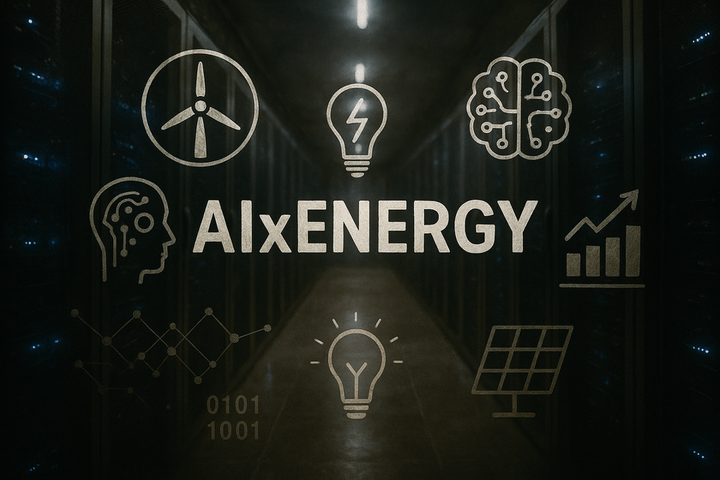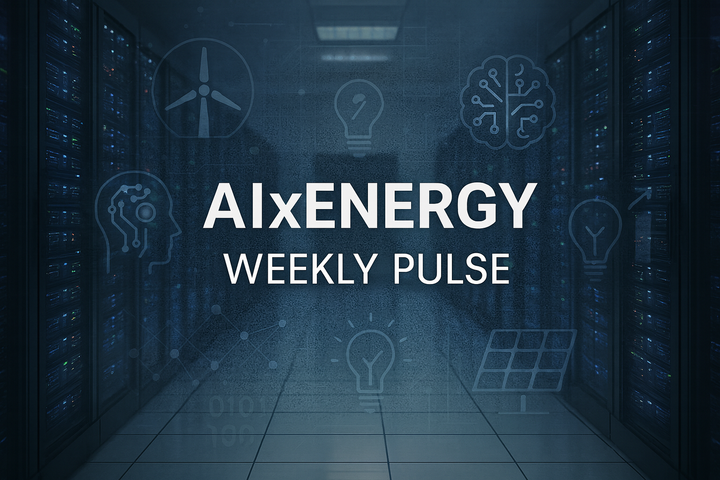09.29.25: AI Sparks Hydrogen Revolution in Zero-Emission Data Centers
AIxEnergy convergence sharpened this week: hydrogen-powered NVIDIA data center set a zero-emission precedent, while Louisiana’s $3B Meta grid deal raised equity alarms. Markets turned to AI for ageing grids and solar waste, signaling a future both electrified and contested.
In a week where the crossroads of artificial intelligence and energy systems unfurled a tapestry of technological innovation and policy challenges, one cannot overlook the audacious strides taken to integrate infrastructure. On the forefront is the pioneering hydrogen-powered, off-grid NVIDIA GB300 NVL72 AI system, illuminating a zero-emission data center as a beacon of green innovation (Hydrogen Fuel News, September 25, 2025). Yet, the landscape is not without its shadows; Louisiana's massive $3B power upgrade for the Meta project, a behemoth straddling the delicate boundary between corporate ambition and public responsibility, raises poignant questions about economic burdens (Renewable Energy World, September 25, 2025). The market, too, is aflutter with change, as strategies for risk reduction in ageing grids become increasingly critical (T&D World, September 23, 2025). Finally, the week's narrative concludes with the tantalizing prospect of a 'solar bump', a potential salve for data centers hemorrhaging wasted energy (Science, Unknown date). As we navigate this labyrinth of AIxEnergy convergence, the emerging patterns suggest a future rife with both strategic opportunities and uncharted challenges.
Infrastructure Integration
As the world grapples with the urgency of carbon neutrality, AI's role in the energy sector is becoming increasingly pivotal. This was exemplified on September 24, 2025, when Lambda, in collaboration with ECL and Supermicro, initiated the first production-grade NVIDIA GB300 system powered entirely by hydrogen in a zero-emission data center (Hydrogen Fuel News, September 25, 2025). This groundbreaking development signifies a strategic shift in the energy landscape, where AI is now being harnessed to integrate renewable energy systems, ensuring cleaner power for data-intensive operations. The fusion of AI and hydrogen technology promises a future where digital infrastructure can operate independently of the grid, eliminating the carbon footprint of conventional energy sources.
Simultaneously, Spain's Orka Energía has launched an AI platform that amasses and updates data on more than 4,000 renewable energy projects (PV Magazine, September 26, 2025). This AI-driven data consolidation mirrors the call by T&D World to unify available smart grid elements (T&D World, September 23, 2025). As AI advances, it is not merely transforming energy generation and consumption but also remolding the entire energy value chain. The ability of AI to synthesize vast amounts of data and provide real-time insights is reshaping energy project management, enhancing efficiency, and accelerating the transition towards sustainable energy. The AIxEnergy convergence is thus emerging as a potent force in actualizing a carbon-neutral future, creating a strategic imperative for industries to adapt swiftly or risk being left behind.
Policy, Regulation & Governance
In the rush to capitalize on the lucrative AI-driven data center boom, there is an emerging trend of states bending to the will of tech titans, evidenced by Louisiana's recent $3 billion power upgrade for Meta (Renewable Energy World, September 25, 2025). However, this development rings alarm bells regarding the potential exploitation of public resources. This sprawling infrastructure project, primarily aimed at fueling Meta's expansive AI initiatives, is being orchestrated with limited state oversight. The question that looms large is whether the public should shoulder the financial burden for a venture that primarily benefits a private entity. The balance between accelerating technological innovation and protecting public interests is a precarious one, and this case exemplifies the tenuousness of this dynamic.
The larger narrative here is the evolving relationship between tech behemoths and state authorities, particularly in the context of AI and energy convergence. As AI weaves its way deeper into the energy sector, the power of tech giants like Meta to influence state policy and direct costly infrastructure projects is growing significantly. This raises critical questions about the nature of governance in the AIxEnergy landscape and the potential for a power imbalance (Renewable Energy World, September 25, 2025). Moving forward, regulators will need to negotiate this complex terrain with astute discernment to ensure that the AI-driven energy transition is both equitable and sustainable. The strategic implications of these dynamics will undoubtedly shape the future of the AIxEnergy sector.
Markets & Business Models
In the tumultuous seascape of the energy sector, AI emerges as a lighthouse, guiding ailing grid systems and the solar industry towards calmer waters. Grid operators, beleaguered by years of underinvestment, are now embracing AI analytics and partial discharge monitoring, harnessing the power of predictive intelligence to forestall failures and bolster system reliability (T&D World, September 23, 2025). Concurrently, as the U.S solar industry braces itself for the impending phase-down of the Investment Tax Credit, AI assistants are being hailed as the next game-changer, equipping installers, EPCs, and financiers with the technological prowess to expedite projects (Solar Power World, September 24, 2025).
The AIxEnergy convergence is not merely a confluence of technologies, but a shift in the tectonic plates of the energy market. The South Korean startup, FuriosaAI, is challenging the GPU dominance with its RNGD server line, promising higher performance at lower costs, and thereby redefining the landscape of the AI inference market (Data Center Knowledge, September 25, 2025). As AI continues to permeate the energy sector, it is vital to anticipate the strategic implications of these shifts. The energy industry must prepare for a future where AI is no longer an optional upgrade, but a requisite for survival and growth, a lynchpin in the evolving mechanics of energy generation, distribution, and consumption.
Compute & Demand Acceleration
As the digital age advances at an unremitting pace, the energy consumption of AI-driven data centers is surging, and with it, the necessity for innovative solutions to manage this voracious appetite. Solar water heaters, in a bid to wrestle back some control, are being employed to recoup approximately 8% of the electricity needs of these AI behemoths (Science, Unknown date). This tactic, akin to a technological sleight of hand, transforms a previously cast-off byproduct - wasted energy - into a valuable asset, contributing towards a more sustainable AI ecosystem. However, the strategic implications of this 'solar bump' extend beyond mere energy recovery. It marks a shift towards more integrative, symbiotic energy systems that not only consume, but also generate and recycle energy, shaping a new paradigm in the AIxEnergy convergence.
Yet, the relentless march of AI and cloud computing technologies continues to drive unprecedented energy demands, pushing the bounds of sustainability (Data Center Knowledge, September 24, 2025). This has sparked a growing interest in fuel cells as a scalable, sustainable on-site power solution for data centers. The advent of fuel cells, proposed by companies like Site Energy, represents not just an isolated development but a broader trend towards decentralizing energy solutions. It signals a shift from reliance on traditional grids towards self-sufficient, on-site energy generation, mirroring the distributed nature of cloud computing itself. This pattern, if it persists, has the potential to redefine the energy landscape, transforming data centers from passive consumers to active participants in energy creation.
Conclusion
In a week where AIxEnergy's landscape was sculpted by both human ingenuity and legislative forces, the convergence of technological advancement and regulatory scrutiny painted a multifaceted picture of progress and challenge. From the labyrinthine circuitry of NVIDIA's GB300 NVL72 AI systems, extracting their lifeblood from hydrogen in an unprecedented off-grid leap towards zero-emission data centers (Hydrogen Fuel News, September 25, 2025), to Louisiana's $3 billion power upgrade for Meta's project, a titan's dance between public interest and private gain (Renewable Energy World, September 25, 2025), the contours of the AIxEnergy ecosystem have been both illuminated and shadowed. Aging grids, like old soldiers not ready to fade away, are offered a lifeline with partial discharge monitoring, turning the tables on obsolescence and risk (T&D World, September 23, 2025). Simultaneously, the tantalizing promise of a 'solar bump' to rescue squandered energy from data centers (Science, Unknown date) adds another layer to the palimpsest of potential solutions. Yet, as we navigate this intriguing terrain, the challenge remains to balance the scales of energy equity, grid resilience, and environmental sustainability, and in doing so, determine who will foot the bill for our collective future.
References
"AI platform compiles data on Spain’s renewable energy projects." PV Magazine, September 26, 2025. https://www.pv-magazine.com/2025/09/26/ai-platform-compiles-data-on-spains-renewable-energy-projects/
"Fuel Cells: The Next Big Thing in On-Site Energy for Data Centers?." Data Center Knowledge, September 24, 2025. https://www.datacenterknowledge.com/energy-power-supply/fuel-cells-the-next-big-thing-in-on-site-energy-for-data-centers
"FuriosaAI Challenges GPU Dominance with New RNGD Server Line." Data Center Knowledge, September 25, 2025. https://www.datacenterknowledge.com/servers/furiosaai-launches-in-house-servers-for-inference-chips
"How AI Is Powering the Next-Gen Electric Grid." T&D World, September 23, 2025. https://www.tdworld.com/smart-utility/article/55314041/tapping-into-the-ai-electric-utility
"Hydrogen Production Powers First Off-Grid NVIDIA GB300 NVL72 AI Systems in Zero-Emission Data Center." Hydrogen Fuel News, September 25, 2025. https://www.hydrogenfuelnews.com/hydrogen-production-powers-first-off-grid-nvidia-gb300-nvl72-ai-systems-in-zero-emission-data-center/8573228/
"Louisiana’s $3B power upgrade for Meta project raises questions about who should foot the bill." Renewable Energy World, September 25, 2025. https://www.renewableenergyworld.com/power-grid/louisianas-3b-power-upgrade-for-meta-project-raises-questions-about-who-should-foot-the-bill/
"Partial Discharge Monitoring and Risk Reduction for Ageing Grids." T&D World, September 23, 2025. https://www.tdworld.com/reliability-and-resiliency/article/55318669/partial-discharge-monitoring-and-risk-reduction-for-ageing-grids/
"Powering AI: From CERA Week Optimism to New York Climate Week Realism." Power Magazine, September 23, 2025. https://www.powermag.com/powering-ai-from-cera-week-optimism-to-new-york-climate-week-realism/
Rishita Sharma. "The Next Big Shift in the Solar Industry: AI Assistants." Solar Power World, September 24, 2025. https://www.solarpowerworldonline.com/2025/09/the-next-big-shift-in-the-solar-industry-ai-assistants/
"A ‘solar bump’ could help data centers recover wasted energy." Science Org, Unknown date. https://www.science.org/content/article/solar-bump-could-help-data-centers-recover-wasted-energy

